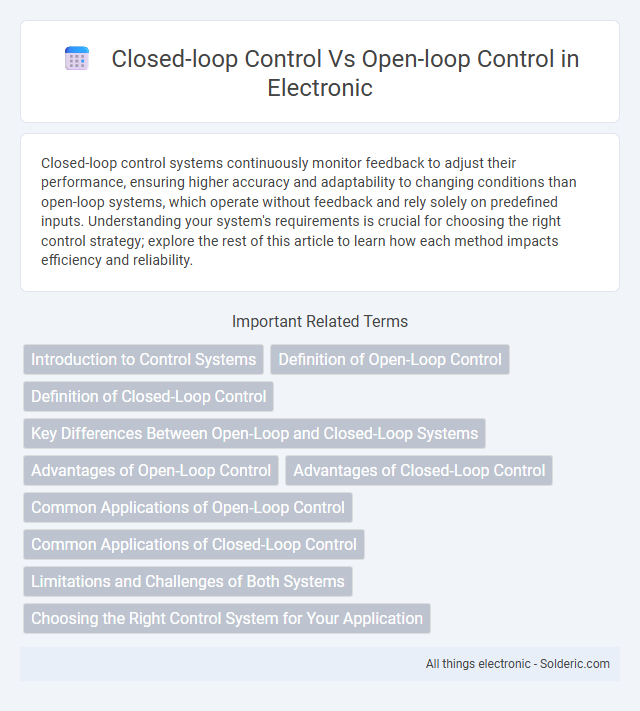Closed-loop control systems continuously monitor feedback to adjust their performance, ensuring higher accuracy and adaptability to changing conditions than open-loop systems, which operate without feedback and rely solely on predefined inputs. Understanding your system's requirements is crucial for choosing the right control strategy; explore the rest of this article to learn how each method impacts efficiency and reliability.
Comparison Table
| Feature | Closed-Loop Control | Open-Loop Control |
|---|---|---|
| Feedback | Uses feedback to adjust system output | No feedback, operates on preset commands |
| Accuracy | High accuracy due to continuous correction | Lower accuracy, no error correction |
| Complexity | More complex and costly | Simple and cost-effective |
| Response Time | Slower due to feedback processing | Faster due to direct command execution |
| Stability | Generally stable, adapts to disturbances | Less stable, sensitive to disturbances |
| Examples | Thermostats, cruise control systems | Microwave ovens, washing machines (basic) |
Introduction to Control Systems
Closed-loop control systems continuously monitor output feedback to adjust inputs, ensuring precise and stable system performance under varying conditions. In contrast, open-loop control systems operate solely on preset inputs without feedback, making them simpler but less adaptable to disturbances or changes. Understanding these fundamental differences is crucial for designing effective control systems in applications ranging from robotics to industrial automation.
Definition of Open-Loop Control
Open-loop control systems operate by sending control signals to a process without using feedback to adjust or correct the output. These systems rely on predefined instructions or input commands, making them simpler but less accurate when facing disturbances or changes in the environment. Industrial applications such as basic timers, washing machines, or simple motor speed controls often utilize open-loop control due to its straightforward design and cost-effectiveness.
Definition of Closed-Loop Control
Closed-loop control is a system where feedback is used to continuously monitor and adjust the output to achieve the desired result. Unlike open-loop control, which operates without feedback, closed-loop control ensures accuracy and stability by comparing the output with a reference input. Your system benefits from enhanced precision and adaptability in dynamic environments through this feedback-driven regulation.
Key Differences Between Open-Loop and Closed-Loop Systems
Open-loop control systems operate without feedback, relying solely on predefined inputs to produce the desired output, which can lead to inaccuracies if disturbances occur. Closed-loop control systems continuously monitor output through feedback sensors to adjust inputs dynamically, ensuring higher precision and stability in varying conditions. Understanding these key differences helps you select the appropriate system for applications requiring either simplicity or accuracy.
Advantages of Open-Loop Control
Open-loop control systems offer simplicity in design and cost-effectiveness due to the absence of feedback components, making them ideal for applications where the output is predictable and disturbances are minimal. These systems provide faster response times since they do not require continuous monitoring or adjustments based on output variations. Open-loop control is advantageous in processes such as timer-based operations or basic motor controls where precision feedback is unnecessary, reducing complexity and maintenance requirements.
Advantages of Closed-Loop Control
Closed-loop control systems offer precise regulation by continuously monitoring output and adjusting inputs to maintain desired performance, reducing errors caused by disturbances or system variations. Your processes benefit from enhanced stability, improved accuracy, and adaptability to dynamic environments compared to open-loop control. This feedback mechanism ensures consistent quality and responsiveness, making closed-loop control ideal for applications requiring high reliability.
Common Applications of Open-Loop Control
Open-loop control systems are commonly used in applications where the process is simple and predictable, such as household appliances like washing machines and microwave ovens. These systems operate based on pre-set instructions without feedback, making them ideal for tasks where precise control or real-time adjustments are not critical. If your application involves consistent, repeatable actions without the need for error correction, open-loop control provides an efficient and cost-effective solution.
Common Applications of Closed-Loop Control
Closed-loop control systems are widely used in applications requiring precise regulation, such as temperature control in HVAC systems, speed control in electric motors, and automated industrial processes. These systems continuously monitor output variables through sensors and adjust inputs to maintain desired performance despite disturbances. Your ability to achieve high accuracy and stability in dynamic environments makes closed-loop control essential for robotics, aerospace, and automotive cruise control.
Limitations and Challenges of Both Systems
Closed-loop control systems face challenges such as increased complexity, higher costs, and potential instability due to feedback delays or sensor inaccuracies. Open-loop control systems suffer from limitations including lack of error correction, susceptibility to disturbances, and reduced precision since they operate without feedback mechanisms. Both systems require careful consideration of application-specific factors like environmental variability and system dynamics to optimize performance and reliability.
Choosing the Right Control System for Your Application
Closed-loop control systems provide real-time feedback, enabling precise adjustments and higher accuracy, making them ideal for applications requiring consistent performance under varying conditions. Open-loop control systems offer simpler design and lower cost, suitable for processes where the relationship between input and output is predictable and external disturbances are minimal. Evaluating factors such as system complexity, accuracy requirements, and environmental variability is crucial when selecting between closed-loop and open-loop control for optimal application performance.
closed-loop control vs open-loop control Infographic

 solderic.com
solderic.com